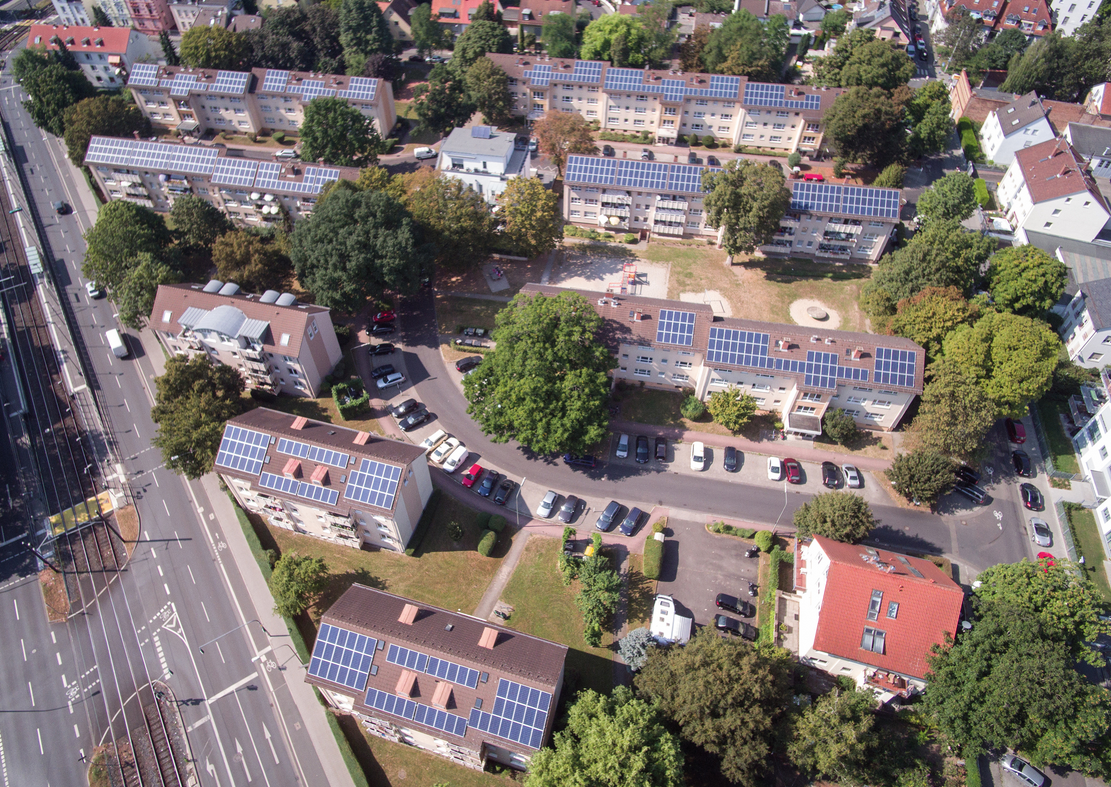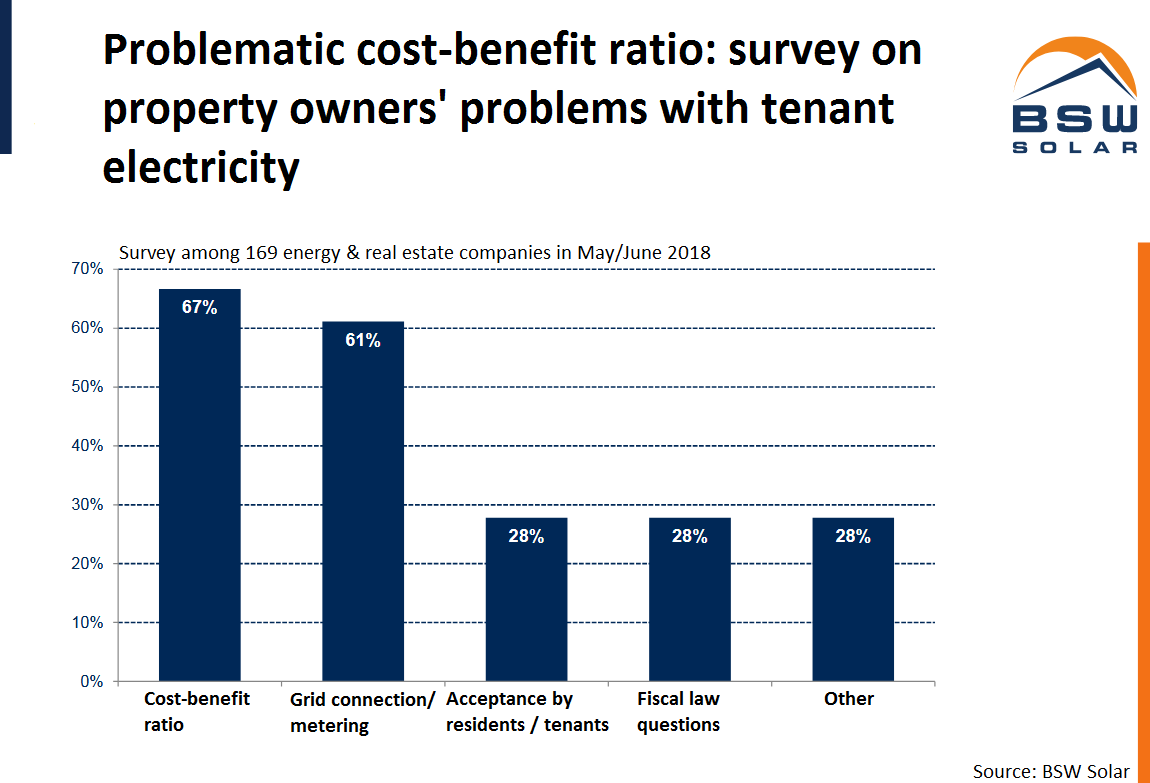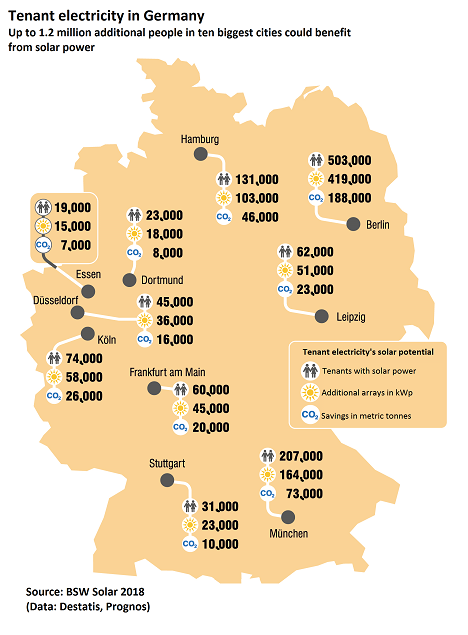Tenant electricity - feeble start for Germany's 'Energiewende at home'

What is tenant electricity?
New solar power modules in Germany are typically supported by granting operators a special payment for every kilowatt-hour (kWh) of electricity they feed into the public grid. A guaranteed payment made by consumers through a surcharge on power bills funds this support. This key feature of Germany’s Renewable Energy Act (EEG) has been a major driver behind investment in renewables such as solar power. Of course, anyone wanting to invest in a renewable energy installation first needs to have an adequate location. This makes it easier for land or building owners to participate in Germany’s Energiewende, the dual shift away from fossil and nuclear power towards renewables and greater efficiency.
For house owners, which can be individual landlords, housing cooperatives or residential property companies, it was not always financially attractive to install solar panels on their roofs and provide power to tenants. Since this kind of electricity – so-called tenant electricity – never passed through the public grid, the operators were not eligible for feed-in remuneration. However, owners would still have to pay the full taxes and levies for grid infrastructure for the big residual volumes of electricity from their panels that could not be used or stored in the building and thus had to be transmitted to the public grid. This significantly cut profit margins and made the investment unattractive.
Germany is set to rely entirely on renewable energy sources in the future. Thus residential buildings that could produce power for nearby power consumers are a valuable resource. In order to unlock potential power production in urban areas, the legal conditions for tenant electricity were altered in 2017 in a bid to incentivise house owners to invest in solar panels.
What is the tenant electricity premium?
Different models of tenant electricity have already existed for several years in Germany. But installing solar panels to provide power for tenants so far has not paid off for landlords. The cost of billing, retailing and metering power in the building often outstripped returns. The new legal framework now allows owners of roof-mounted arrays to also receive support under the EEG and at the same time frees tenants from paying taxes and levies on the electricity they use. This makes the concept more attractive for house owners. In most cases, the operation of the arrays is carried out by service companies hired by the house owners.
Instead of feed-in payments, these companies receive a so-called tenant electricity premium from grid operators for every kilowatt-hour (kWh) provided to tenants, which the Federal Network Agency (BNetzA) calls a “special form of the EEG renewables support.” The exact level of support is aligned with the EEG’s regular feed-in remuneration for roof-mounted solar power arrays and ultimately depends on the installation’s size.
However, this remuneration is lower than regular support as there are no expenses (grid fees, power taxes, etc.) from providing power to tenants. Also, the house owner also earns money from the direct power sales to tenants. The maximum supported capacity is 100 kilowatts. Only installations built and registered with the BNetzA after the law was introduced in July 2017 are eligible.
How big is tenant electricity’s potential in Germany?
According to the economy ministry, up to 3.8 million flats in the country could be supplied with tenant electricity, nearly ten percent of all flats in Germany. A study commissioned by the ministry says up to 14 terawatt hours (TWh) of additional renewable power annually could be generated with tenant electricity. This would occur in an ideal scenario in which solar arrays are installed in all 360,000 buildings suitable for the concept. This is slightly more than the annual output of one modern nuclear power plant.
The premium for tenant electricity is meant to “directly include tenants in the energy transition,” Germany’s economy and energy ministry (BMWi) says. Tenants are still free to choose a different power provider than their landlord, and tenant electricity prices are not allowed to exceed a given cap. This is meant to ensure that landlords make financially attractive offers to the building’s residents. Any contract with the landlord therefore also has a limited term and must not be coupled with the tenancy agreement.
According to the BMWi, tenant electricity will help to bring solar power from rural into densely populated conurbations, thereby reducing the pressure to increase the capacity of long-distance transmission grids. It estimates that roughly one third of the power produced by tenant electricity installations will be used by tenants, while most of it will end up in the public grid.
What are the concept’s difficulties?
The energy ministry’s comprehensive tenant electricity study found that in a scenario in which tenant electricity’s potential is fully exploited, the additional renewables support combined with lost earnings from grid fees etc. would amount to a financial shortfall of 1.25 billion euros for the state. Part of this deficit in receipts then would have to be shifted to regular power customers. However, the study stresses that this is only a short-term scenario and very unlikely to occur in reality.
“Since the total costs that need to be allocated [among power customers] will not be lowered thanks to tenant electricity, the power costs for other households and businesses will rise proportionally to the number of tenants benefiting from the privilege,” the energy ministry says.
To limit the additional costs from the tenant electricity premium, support is limited to an additional solar power capacity of 500 megawatt (MW) per year. However, additional support payments would have to be made regardless of whether a new solar array is used for tenant electricity or for regular solar power production.
What do critics say?
Solar power industry lobby group BSW Solar is not convinced that the government’s tenant electricity scheme fulfils its goals. Unnecessary tax barriers for operators and bureaucratic hurdles for panel installation continue to deter potential investors who want to use tenant electricity as an extra income, the group says in a statement released together with real estate industry association GdW.
In a survey held one year after the law’s introduction, over two thirds of respondents in Germany’s solar and energy industry said they were not satisfied with the scheme. Reasons for not investing in tenant electricity models were tax burdens on operators, the continued EEG surcharge on directly supplied solar power and the lack of simple metering and billing schemes.
The German Association of Energy and Water Industries (BDEW) criticised that especially in densely populated areas, there could be a “substantial redistribution” of costs from users of tenant electricity to those who fully depend on the public grid. This could undermine the Energiewende’s acceptance, the BDEW warns.
What’s the state of play in tenant electricity policy?
The German government’s plan to cut support for solar arrays with a capacity over 40 kilowatts by 2019 has irked many solar power industry representatives, with some calling the policy “effectively the end of tenant electricity support”. Critics like industry lobby group BSW Solar or the Association of Energy Market Innovators (BNE) argue that the cuts are unnecessary since only one percent of the annual support limit of 500 MWp had been used within the policy’s first year.
The Bundesrat, the federal representation of Germany’s 16 state governments, has also criticised the proposed reform. It says support cuts should be much smaller than proposed and should also only take effect after a transition period lasting until at least mid-2019. The Bundesrat explicitly said that tenant electricity projects need more backing from policymakers and no further hurdles.
The government considered the objections by industry representatives and the Bundesrat and decided to limit cuts to tenant electricity support and introduce them later than planned. However, for the solar industry, the amendments aren’t enough to avoid negative consequences for tenant electricity expansion. “Tenant electricity has not been killed off completely for now,” the BNE commented on the government’s law amendments made in late 2018, but said the legislative reform did little to decrease bureaucratic hurdles to private power generation with solar modules.
The Federation of German Consumer Organisations (vzbv) said the new laws have worsened the position of citizens willing to invest in tenant electricity. While three quarters of respondents in a vzbv survey said the concept would be interesting for them, the cut in support contravenes using people’s readiness to directly support the energy transition from home, the organisation said.



